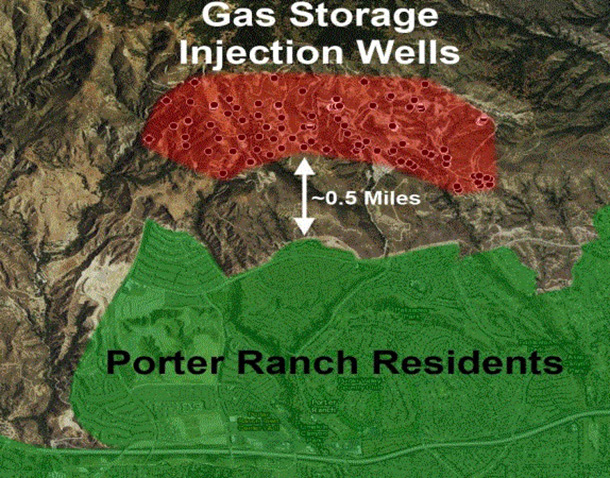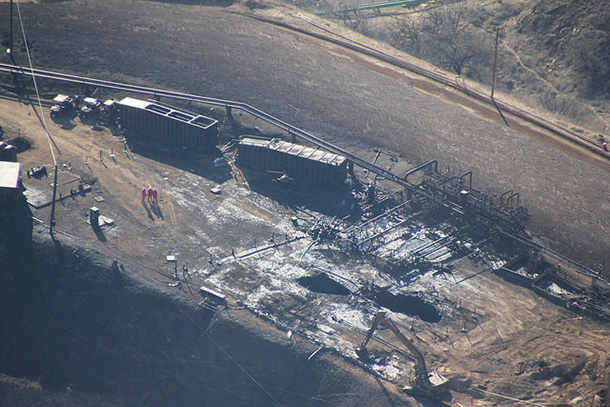A massive methane leak from an aging underground gas storage facility in a community north of Los Angeles illustrates the grave environmental and safety hazards that come with operating gas storage fields near cities due to the frequency of well leaks, experts have shown.
Since Oct. 23, thousands of citizens have been displaced or sickened with nosebleeds and headaches by hydrocarbon pollution from a leaky injection well site at the Aliso Canyon storage facility, one of the largest underground storage sites in North America.
Industry stores methane underground in depleted oil and gas fields, aquifers or salt caverns for future use because it is more economic than storing the gas in tanks on the surface.
The owner of the facility, the Southern California Gas Company (SoCal), has spent $50 million to try to shut off the gigantic leak, but so far with no success.
In November, the California Air Resources Board reported that methane was spewing from the storage facility into the atmosphere at an approximate rate of 50,000 kilograms per hour, or nearly 1,200 tonnes of climate-warming gases a day. At one point, the leak was estimated to account for one-quarter of all methane emissions in the state.
The Environmental Defense Fund calculated two months ago that the massive methane gusher would have a climate-warming impact greater "than all of California's petroleum refineries combined, or six large coal fired power plants, or roughly seven million passenger vehicles."
To date, SoCal has failed to plug the leak in a nearly 50-year-old well casing located 500 feet underground. The casing is part of one of 154 wells (only 93 are active) that can inject natural gas into the storage facility. All could serve as pathways for leaks to the surface or groundwater.
A class action lawsuit against the operator of the facility alleges the leak "has unleashed an uninterrupted flow of gases and fluids, including methane, methyl mercaptan, and aromatic hydrocarbons that has sickened hundreds of the 30,000 residents who live in Porter Ranch."
Added the lawsuit: "The difficulties faced by SoCal Gas in controlling the high-pressure leak in one injection well are surely exacerbated by any continued high-pressure injection of billions of cubic feet of natural gas into the same shared gas-storage reservoir."
The company says that there are no injections currently taking place.
Nearly 10 weeks after the storage facility sprang its leak, California Governor Jerry Brown declared a state of emergency to ensure that seven separate state agencies can be deployed to track, monitor and help stop the industry-made methane gusher. Last month he described SoCal's efforts to plug the leak as "insufficient."
Leaks a chronic hazard, say experts
While the massive gas leak may have come as a surprise to the Californian residents forced to evacuate their homes, reports and studies by petroleum experts over the years have repeatedly warned that gas storage sites have demonstrated a long history of gas migration problems.
Major leaks from underground gas storage sites have caused explosions, groundwater contamination and lawsuits in Kansas, Texas, California and Colorado.
Moreover, the public record shows "that using depleted oil fields for gas storage facilities can create a serious risk of explosions and fires, especially when located in urban settings," according to a well-read industry textbook authored by four engineers and consultants entitled Gas Migration.
The experts explain that gas stored in abandoned oil fields can be over-pressured by repeated gas injection, which in turn creates vertical fractures in rock and thereby increases the risk of leaks to the surface.
The breakdown of cement seals on active and abandoned wells is a common source of leaks from underground storage facilities. In fact, many oil and gas wells will leak methane over time, and represent a multibillion-dollar liability for the hydrocarbon industry.
According to the Los Angeles Daily News, a filing with California regulators shows that SoCal knew that its pipes and injection wells at the facility were corroding and failing at an increasing rate prior to the disaster, though a state official reportedly said it doesn't appear the company violated any regulations.
In a specific chapter on the hazards of gas storage, the textbook authors added that "it is virtually impossible to ensure that the gas will not migrate to the surface" through faults and abandoned or aging wells. "Especially in the case of earthquakes the faults may become more permeable and there could be an upsurge of gas to the surface."
California petroleum engineer Brent Miyazaki also highlighted the problem of leaking wells in a 2009 textbook called Underground Gas Storage.
Miyazaki warned that badly sealed wells remained a major issue at gas storage sites because gas injection, just like hydraulic fracturing, routinely subjects oil and gas plumbing to pressure fluctuations and much rattling.
As a result, there is "a high probability of developing leaks and other containment failures" at underground storage sites, Miyazaki wrote.
He also wrote in the 2009 textbook that California allowed regulatory authorities to conduct reviews and issue permits without "maintaining staff with the technical backgrounds to expertise to evaluate hazards."
As a result, "some issues are ignored or never evaluated, leaving the potential for future incidents unchecked," Miyazaki wrote.
A 2005 study by Bernard Endres and famed petroleum geologist George Chilingar also warned that the building of urban neighborhoods above aging oil fields and gas storage sites in general exacerbated these existing hazards and was a recipe for disaster and lawsuits.
Much of Los Angeles has developed on depleted oil and gas fields, and the leaking well at the Aliso Canyon facility is less than one mile from the housing development of Porter Ranch.
To avoid major explosions and other emergencies, the researchers called for better oil and gas monitoring, extensive air testing, and routine gas migration studies for old or aging gas and oil fields located in cities or near urban populations. Few regulators adopted any of these recommendations.
The researchers noted that energy regulators routinely put public safety at risk by allowing oil and gas facilities and housing developments to share the same land.
Leaks pervasive across North America
The problem of leaking wells, whether used for injection of wastes or fluids or for extraction, is pervasive and badly monitored.
Canadian researchers warned in a 2014 University of Waterloo report that methane seeping from the nation's 500,000 oil and gas wells, active or abandoned, represents "a threat to environment and public safety" due to groundwater contamination, greenhouse gas emissions, and explosion risks wherever methane collects in unvented buildings and spaces.
Around the world, underground gas storage sites contained approximately 377 billion cubic metres of methane in 688 facilities in 2013. More than two-thirds of these operations were located in North America: 414 in the U.S. and 59 in Canada.
The majority of the North American facilities are all located in depleted gas and oil fields, where natural faults and fractures as well as the leaking of abandoned or poorly plugged wells remains a chronic problem.
Anthony Ingraffea, a professor of engineering at Cornell University, told Living On Earth radio that corroded and aging oil wells repurposed as injection wells are at the heart of the problem at Aliso Canyon and other underground gas storage sites. "Everything put together falls apart especially when its underground... this is the tip of the iceberg. There are tens of thousands of these wells."

SoCal describes the storage facility as a vital energy supply for 21 million people. The facility provides "reliable, reasonably-priced natural gas service to our customers to heat their homes, cook their food and power their businesses, 24/7. When the wind doesn't blow, or the sun doesn't shine for renewable electric generators, the natural gas from Aliso Canyon helps to fill the gaps."
Given the problems at underground gas storage facilities, a 2014 U.S. study by the National Agricultural and Rural Development Policy Centre found that homes located near such leaking infrastructure suffered harm as well as significant property devaluation.
"Our results indicate that underground natural gas storage activities bear risks that are substantial enough to affect nearby residents, and that these impacts are more severe in proximity, concentration, and for properties without access to public water. " ![]()
Read more: Environment
















Tyee Commenting Guidelines
Comments that violate guidelines risk being deleted, and violations may result in a temporary or permanent user ban. Maintain the spirit of good conversation to stay in the discussion.
*Please note The Tyee is not a forum for spreading misinformation about COVID-19, denying its existence or minimizing its risk to public health.
Do:
Do not: